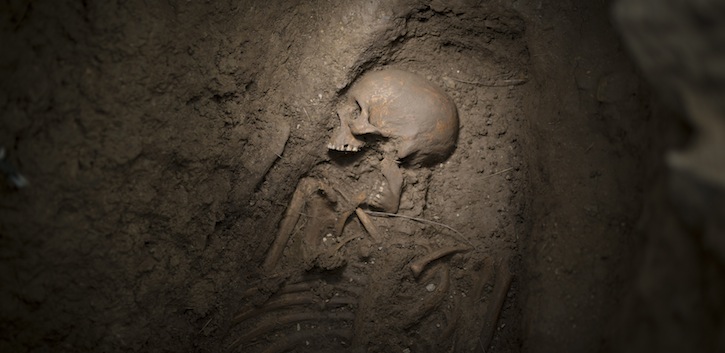2013 Press Releases
What lies beneath Ireland’s Alcatraz?

In the first collaboration of its kind between UCC and the Irish Examiner, a five-part documentary series filmed by UCC cameraman Stephen Bean charts a major archaeological research project which was conducted on Spike Island in Cork Harbour earlier this year.
See the whole documentary series here: http://www.irishexaminer.com/spike-island-documentary/
The prison hulks floating in Cork Harbour may be long gone, but more than one thousand prisoners buried in the surrounds of Spike Island offer a lasting testament to an unforgiving period in Irish history. A team of 23 student archaeologists, drawn from UCC and various universities in North America, descended on Spike, which commands the entrance to Cork Harbour, to dig a little deeper earlier this summer. Along with their project director, Dr Barra O'Donnabhain, Department of Archaeology UCC and four supervisors, all postgraduate students, their work has resulted in a five-part documentary series filmed by UCC cameraman Stephen Bean, which offers a unique window into a brutal 36-year period in the late 19th century. 1847-1883 saw what some coin ‘Ireland’s Alcatraz’ used as a prison for convicts bound for the penal colonies of Australia, Bermuda and further afield.
While a rich body of documentary sources already exists on Spike’s role as a prison, these only tell one side of the story, that of the authorities of the day. The documents are silent on the lives of theconvicts and on those of most of the front-line staff. In an endeavour thatwouldn't look out of place in an Indiana Jones flick, the team set out to investigate daily life in the prison and the triangle of relationships between convicts, warders and the institution. By unearthing material culture - theobjects used on a daily basis – they have brought to light fresh insight into these relationships and both the official and unofficial economies of the prison, including the black economy that existed between convicts (and their keepers) and the evidence of passive resistance to the prison regime,such as graffiti and smuggled goods.
Funded by Los Angeles-based Institute for Field Research (www.ifrglobal.org) and Cork County Council (in whose care the island is vested), the project was established in 2012 with seed funding from the College of Arts, Celtic Studies and Social Sciences (CACSSS) at UCC. While Spike itself potentially has a 10,000-year archaeological history, the research project very deliberately focuses on this distinct period, says Dr O'Donnabhain:
“A former military barracks, Spike was converted into a prison in 1847, in response to the rise in public disorder that characterised the Great Famine (1845-1852). Spike is unusual for a late 19th century penitentiary in terms of its design and the numbers of convicts confined there (2300 in 1851 of a total Irish convict population of 4090). The architecture of many of the purpose-built prisons from this period reflects new ideas about the redemptive nature of isolation, discipline and work. In its early years, the prison population was noted to be sick and malnourished with many convicted to long sentences for relatively trivial offences. The prison regime was harsh and characterised by hard labour. Thelandscape of the island today, along with the form of Haulbowline dock and that of many of the other military installations around the harbour, reflect theinput of forced labour.”
“The physical isolation of convicts was not possible on Spike Island which was a military installation pressed into service as aprison. Unlike the city and county jails, it served the entire island of Ireland. Dealing with criminals by means of long-term incarceration is a relatively recent development. In Ireland and Britain, long-term confinement only became the dominant means of punishment and social control in the early decades of the 19th century.”
The annual reports of the Inspectorate of Prisons show that the suitability of the fort was regularly questioned and as transportation waned, the prison was closed in 1883. From 1985-2004, it once again housed prisoners courtesy of the Irish Prison Service. It very nearly reprised itsinfamous role for a third time as recently as 2006, when then Minister for Justice Michael McDowell proposed a new prison be constructed. A reprieve came when Cork County Council took it over to re-develop as a tourist attraction, and the island is now a national monument.
The data uncovered by the Spike Archaeological Project, some of which stemmed from geoinformatics technologies, including terrestrial laser scanning, will play an important role in the on-going development of the site as a cultural heritage venue. The convict past provokes different reactions in Ireland and in those parts of the world populated by the descendants of prisoners. However, this project has relevance beyond Ireland and the Irish diaspora: the 19th century was a critical period for the development of the modern prison system with considerable innovation and experimentation in methods of incarceration. Spike Island was one of the locations where such experimentation was carried out. It was also one of the hubs of a penal system that had a global reach. The Project gives voice to the lived experience of incarceration while also broadening our understanding of the evolution of our prison systems and of the role of the convict as one of the mechanisms by which empire was established and maintained.
The footfalls now brought by tourists departing from Cobh in the summer are a world away from the unrelenting misery of all those who found themselves on Spike Island between 1847-1883. This documentary series offers untold and gripping insight into the lives of those confined to ‘Ireland’s Alcatraz’.
